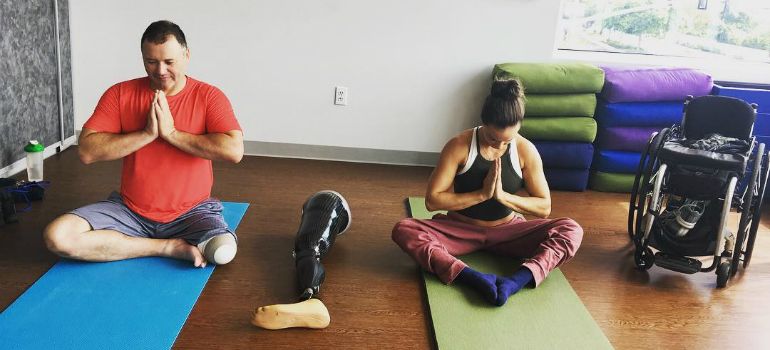Yoga is a spiritual and physical discipline celebrated for its positive influence over health, pain relief, and relaxation. Practicing yoga is beneficial for people of all abilities, body types, and fitness levels. It is credited for reducing aches & pains and promoting general wellbeing & positive mental health.

Yoga is a very adaptable exercise, and can be easily practiced from a seated position or otherwise modified to your needs. Because of this, yoga is highly suitable for wheelchair users and other people with disabilities. There are numerous adapted yoga positions which can be incorporated into the physical therapy or exercise routines of people with disabilities.
The Benefits of Yoga
Yoga can be a beneficial addition to anybody's lifestyle, but it is known to be particularly useful for those who experience chronic pain or muscular weakness.
Some of the benefits of yoga include:
- Increased strength, flexibility, and balance
- Decreased stress and anxiety through heightened relaxation
- Relief from the pressure of being in a seated position
- Improved posture
- Increased blood flow and reduced blood pressure
- Improved bone and muscle health
- Lowered cortisol levels and better regulated adrenal glands
- Improved mood and focus
- Deeper, more replenishing sleep
- Strengthened joints and connective tissues
- Strengthened muscles to increase ease of daily tasks such as wheelchair transfers
- Yoga groups and classes can also offer added social benefits
Wheelchair Friendly Yoga Poses
Practicing yoga in a wheelchair is not only possible, but it is also common and very fun!
Since yoga is very adaptable by nature, almost any pose can be altered to be performed from a seated position. Poses can also be modified to accommodate other disabilities or injuries, such as changing an arm position or angle. As with any new exercise routing, it is advisable that you consult with a medical professional before beginning.
Here are some of the most common adaptive yoga poses:
The Cat Pose
To begin, you may choose to either grip the sides of your chair or place your hands on your thighs in front of you. Spend a few moments breathing in and out, and let your muscles and body relax. Remember to keep your breathing slow, even, and relaxed.
Inhale, then exhale slowly as you lean your upper body forward, drop your chin down, and arch your back. Hold this position for a few deep, calm breaths and then gently return to an upright position.
The Eagle Pose
Inhale slowly and lift your arms so that they are in front of you. Your elbows should be bent at a 90-degree angle with your forearms pointing toward the sky.
As you exhale, cross your arms over each other at the elbows and rest the backs of your hands together.
Hold this position with arms out in front of you for 20 to 30 seconds. Remember to continue to breathe slowly and deeply as you stretch your muscles in this pose.
Hip Stretch
As you inhale, lift one of your legs and rest it gently so that it crosses over your other leg. At this point, if you have good core stability, you may choose to lean forward slightly from your hips holding your chair for support. Breathe slowly and deeply, staying in this stretch for 3 to 5 breaths.
Slowly bring your leg back to its regular position and repeat the stretch on the other side.
Forward Bend
Inhale deeply and straighten your back as much as possible so that you are standing tall. Exhale and bend forward from your waist, ensuring that you hold on to your wheelchair for support as you move. Hold this position for up to 5 breaths, and then slowly move back into your seated position.
The Twist
Inhale deeply as you slowly rest your right hand on top of your left leg, using your left arm for support. Exhale and turn to look over your left shoulder, holding this position for up to 5 breaths. Gently release from this position and return to your original seated position. Take a few deep breaths and then repeat the stretch on the opposite side.
Leg Stretch
Inhale and stretch your back by sitting up tall in your wheelchair. Exhale slowly and wrap your hands around the back of your leg or shin. Lift your knee so that it is at a comfortable level, and hold this position for up to 5 breaths. Gently release the stretch and repeat it for your other leg.
Yoga is a great way to strengthen the body while also working to reduce pain and promote overall well being. Because of its flexible and adaptable routine, yoga is easy to modify to your personal capabilities, and is a useful addition to anyone's daily exercise routine.
Most of the stories here on LiveQuickie.com were submitted by readers. Do you have a story to tell? We'd love to hear it. Submit your story here.